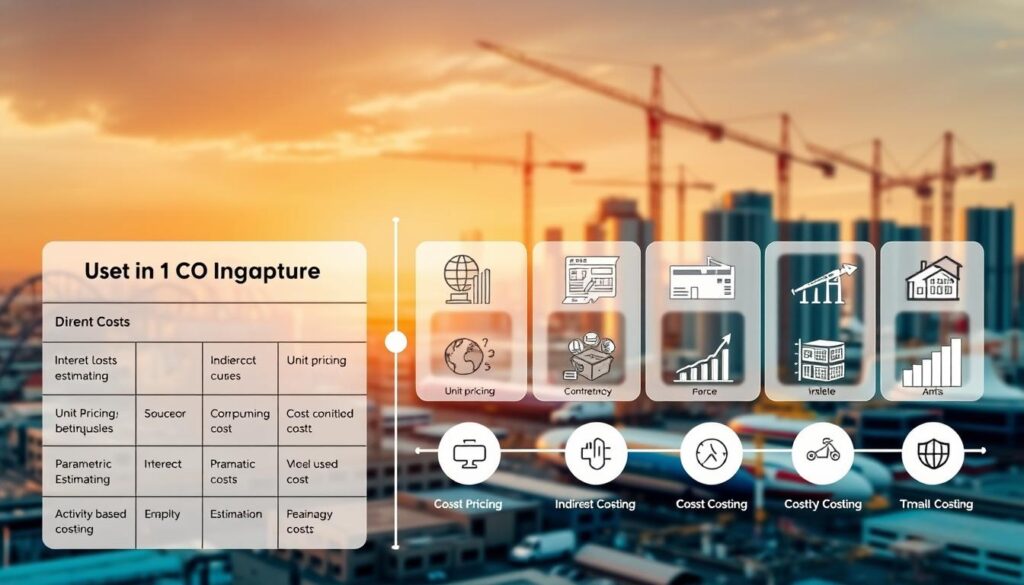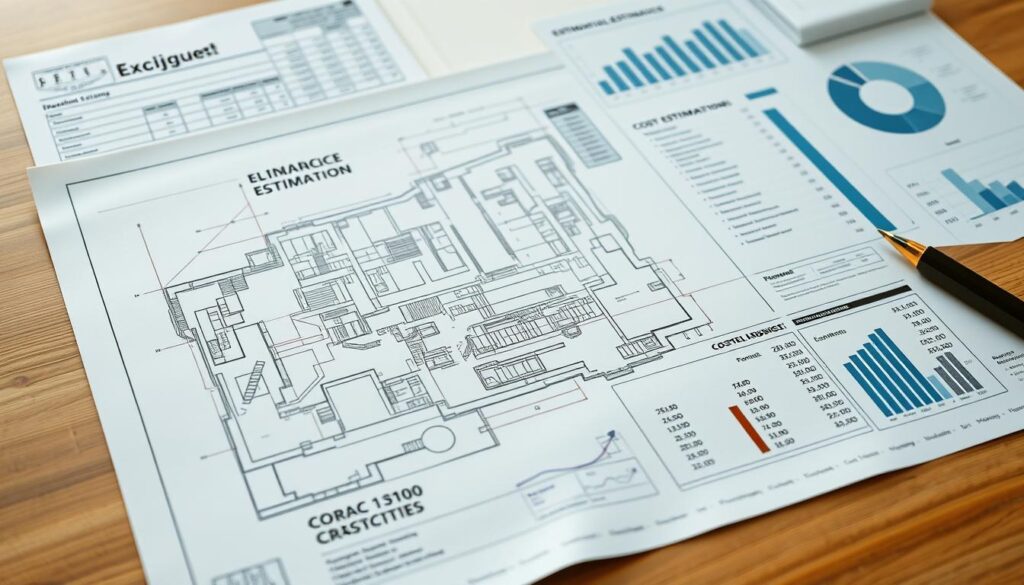Did you know that a significant 30% of civil engineering projects face cost overruns due to inaccurate cost estimation? This staggering statistic underscores the critical importance of mastering estimation and costing in the civil engineering sector. Accurate cost estimation is not just a procedural task; it’s a cornerstone of project planning, budgeting, and decision-making.
Accurate cost estimation ensures project feasibility and profitability by providing a clear financial roadmap. It enables project managers to allocate resources effectively, anticipate potential financial pitfalls, and make informed decisions that drive project success.
Key Takeaways
- Accurate cost estimation is crucial for civil engineering project success.
- Mastering estimation and costing enhances project feasibility and profitability.
- Effective cost estimation aids in resource allocation and financial planning.
- It enables project managers to anticipate and mitigate financial risks.
- Informed decision-making is facilitated through precise cost estimation.
Understanding the Basics of Estimation and Costing
Estimation and costing are fundamental components in the successful execution of civil engineering projects. They form the foundation upon which project feasibility, budgeting, and overall financial management are built.
To grasp the intricacies of civil engineering projects, it’s essential to understand the definitions and processes involved in estimation and costing. These two interrelated concepts are crucial for determining the financial viability and budgetary requirements of a project.
Definition of Estimation in Civil Engineering
Estimation in civil engineering involves calculating the quantities and costs of materials, labor, and equipment required for a project. This process is critical for determining the initial investment needed and for planning the project’s execution. Estimation is not just about predicting costs; it’s also about understanding the project’s scope, timeline, and resource allocation. For more detailed information on construction estimating, you can visit Procore’s construction estimating library.
Definition of Costing in Civil Engineering
Costing in civil engineering includes determining the total cost of a project, encompassing both direct and indirect costs. Direct costs are those directly attributable to the project, such as materials and labor, while indirect costs include overheads, administrative expenses, and other expenditures not directly tied to the project’s physical construction but necessary for its completion. Accurate costing is vital for budgeting and financial planning, ensuring that the project is completed within the allocated financial resources.
In summary, understanding the basics of estimation and costing is pivotal for the success of civil engineering projects. These processes are interlinked, with estimation focusing on the quantification and initial cost assessment of project components, and costing delving into the comprehensive financial analysis required for project execution.
Importance of Accurate Estimation in Projects

Accurate estimation is the backbone of any successful civil engineering project. It ensures that projects are completed on time and within budget, thereby preventing cost overruns and ensuring project viability. Accurate construction estimating is crucial for the financial health of a project.
Why Accuracy Matters
Accuracy in estimation matters because it directly impacts the project’s bottom line. Precise estimation helps in allocating resources effectively, avoiding financial losses, and ensuring that the project is feasible. It also aids in securing funding by presenting a clear and realistic budget to stakeholders.
Moreover, accurate estimation enhances the credibility of the project managers and the construction company. It reflects a thorough understanding of the project’s requirements and challenges, thereby instilling confidence in clients and investors.
Risks of Poor Estimation
Poor estimation can lead to a myriad of problems, including cost overruns, project delays, and even project abandonment. Inaccurate estimation can strain the financial resources of a company, damage its reputation, and lead to legal disputes with clients or contractors.
Furthermore, managing a civil engineering project with poor estimation can result in inefficient resource allocation, increased stress on the project team, and a higher risk of project failure.
By understanding the importance of accurate estimation and the risks associated with poor estimation, civil engineering professionals can better manage their projects, ensuring they are completed successfully and sustainably.
Different Types of Cost Estimates
The process of cost estimation in civil engineering is multifaceted, involving several distinct types of estimates that serve various purposes throughout a project’s lifecycle.
Cost estimates are crucial for project planning, budgeting, and cost control. They help stakeholders make informed decisions and ensure that projects are completed within budget and on time.
Preliminary Estimates
Preliminary estimates are used in the initial stages of a project to provide a rough estimate of the costs involved. These estimates are typically based on historical data, industry benchmarks, or preliminary designs.
Preliminary estimates help clients and project managers decide whether to proceed with a project. They are also useful for comparing different project alternatives.
Detailed Estimates
Detailed estimates, on the other hand, are more accurate and are prepared after the project design is complete. These estimates involve a thorough analysis of the materials, labor, and equipment required for the project.
Detailed estimates are used for budgeting and financing purposes. They are also essential for contractors who need to bid on projects.
Control Estimates
Control estimates are used during the project execution phase to monitor and control costs. These estimates help project managers identify potential cost overruns and take corrective action.
Control estimates are typically updated regularly to reflect changes in the project scope, schedule, or costs.
By understanding the different types of cost estimates, civil engineers and project managers can better manage project costs and ensure successful project outcomes. Utilizing cost estimation software and construction cost calculators can further enhance the accuracy and efficiency of the cost estimation process.
Key Factors Influencing Cost Estimates

Several key elements play a crucial role in determining the cost estimates for civil engineering projects. Understanding these factors is essential for accurate estimation and successful project execution.
Material Costs
Material costs are a significant component of the overall cost of a civil engineering project. The cost of materials can fluctuate based on market conditions, availability, and quality. Accurate estimation of material costs requires up-to-date market data and a thorough understanding of the project’s material requirements.
- Market prices for materials like steel, concrete, and asphalt
- Availability and lead times for specific materials
- Quality specifications and their impact on material costs
For more detailed information on estimating and costing in civil engineering, you can visit Construct Estimates.
Labor Expenses
Labor expenses are another critical factor influencing cost estimates. Labor costs can vary significantly based on location, skill level, and labor market conditions. Efficient labor management is crucial for controlling these costs.
- Labor rates and their variation by location and skill level
- Labor productivity and its impact on overall project costs
- Labor laws and regulations affecting labor costs
Overhead and Profit Margins
Overhead costs, including administrative expenses, equipment, and facilities, also significantly impact the overall cost estimate. Additionally, profit margins are essential for the sustainability of the project. Balancing overhead costs and profit margins is vital for the project’s financial health.
- Administrative and operational overhead costs
- Equipment costs and depreciation
- Profit margin considerations and their impact on project viability
By understanding and accurately estimating these key factors, civil engineers can develop more reliable cost estimates, ensuring better project planning and execution.
Estimation Techniques in Civil Engineering
Effective cost estimation is a cornerstone of successful civil engineering projects, achieved through various estimation techniques. These techniques enable engineers to predict costs accurately, ensuring projects are completed within budget. In this section, we will explore the different estimation techniques used in civil engineering.
Analogous Estimation
Analogous estimation involves using the cost of similar, completed projects as a basis for estimating the cost of the current project. This technique is particularly useful when there is limited detailed information available about the current project. It relies on historical data and can provide a quick estimate. However, its accuracy depends on the similarity between the projects.
Parametric Estimation
Parametric estimation uses statistical models to estimate costs based on specific project parameters. This technique involves identifying key cost drivers and developing a mathematical model to predict costs. It is more accurate than analogous estimation because it is based on a detailed analysis of project variables. Parametric models can be simple or complex, depending on the project’s requirements.
Bottom-Up Estimation
Bottom-up estimation involves breaking down a project into smaller components, estimating the cost of each component, and then summing these costs to obtain the total project cost. This technique is time-consuming but highly accurate because it considers the details of every project element. It is particularly useful for complex projects where detailed cost breakdowns are necessary.
Each of these estimation techniques has its advantages and is suited to different project requirements. By understanding and applying these techniques, civil engineers can improve the accuracy of their cost estimates, contributing to the successful completion of projects. For more insights into how these techniques are applied in project management, visit Civil Engineering in Project Management.
- Analogous estimation relies on historical data from similar projects.
- Parametric estimation uses statistical models based on project parameters.
- Bottom-up estimation involves detailed breakdowns of project components.
By leveraging these estimation techniques, civil engineers can better manage project costs and ensure that projects are financially viable. The choice of technique depends on the project’s complexity, available data, and the level of detail required.
Tools and Software for Cost Estimation

The advent of digital tools has transformed the landscape of cost estimation in civil engineering. With the help of sophisticated software, professionals can now achieve higher accuracy and efficiency in their estimates.
Popular Estimation Software
Several software solutions have gained popularity among civil engineers for cost estimation. These include building information modeling (BIM) tools and specialized cost estimation software. For instance, visiting this resource can provide insights into the best construction estimating software available.
Some of the key features of these software include the ability to perform quantity takeoffs, generate detailed cost breakdowns, and integrate with project management systems. This not only streamlines the estimation process but also enhances collaboration among project stakeholders.
Advantages of Digital Tools
The use of digital tools for cost estimation offers numerous benefits. These include increased accuracy, improved efficiency, and the ability to easily update estimates as project details change. Moreover, digital tools can facilitate better decision-making by providing real-time data and analytics.
By leveraging construction cost calculators and other digital solutions, civil engineers can produce more reliable project cost estimations. This, in turn, can lead to better project outcomes and reduced financial risks.
The Role of Quantity Takeoff in Estimation
Accurate quantity takeoff is essential for reliable construction estimation, as it directly impacts project costs. Quantity takeoff is a critical step in the estimation process, involving the detailed calculation of materials and quantities required for a project.
What is Quantity Takeoff?
Quantity takeoff is the process of identifying and quantifying the materials and labor needed to complete a construction project. It involves a thorough review of project plans and specifications to determine the quantities of materials such as concrete, steel, and electrical components.
For instance, a quantity surveyor might use software tools to measure lengths, areas, and volumes from architectural drawings to estimate the total amount of materials required. This process is fundamental in creating an accurate and comprehensive construction budget.
Steps in Conducting Quantity Takeoff
Conducting a quantity takeoff involves several systematic steps:
- Review project plans and specifications to understand the scope of work.
- Identify and list all materials and labor required for the project.
- Measure and calculate the quantities of each material and labor component.
- Verify the calculations to ensure accuracy and completeness.
- Document the findings in a detailed report.
For a detailed guide on construction cost estimation, you can visit https://worldcivilsociety.com/construction-cost-estimation/ to explore more resources and insights.
As emphasized by industry experts, “Quantity takeoff is the backbone of construction estimation, providing the necessary data to create realistic project budgets.” – Construction Industry Expert
| Step | Description | Importance |
|---|---|---|
| 1. Review Plans | Understand project scope | High |
| 2. List Materials | Identify required materials | High |
| 3. Calculate Quantities | Measure materials and labor | Critical |
By following these steps and utilizing modern software tools, quantity takeoff can be performed efficiently and accurately, ensuring that construction projects are well-planned and executed within budget.
Costing Methods Used in Civil Engineering

Effective costing is a cornerstone of civil engineering, influencing project feasibility and profitability. Various costing methods are employed to ensure that projects are financially viable and sustainable.
The choice of costing method can significantly impact the outcome of a project. Civil engineers must understand the different methods available to make informed decisions.
Direct Costing
Direct costing involves attributing costs directly to the production of goods or services. This method is straightforward and helps in identifying the direct expenses associated with a project, such as labor and materials.
Advantages of Direct Costing:
- Simplifies cost attribution
- Helps in identifying direct expenses
- Useful for short-term decision-making
Indirect Costing
Indirect costing, on the other hand, involves costs that are not directly attributable to the production process but are necessary for the operation of the business. These include overheads such as administrative salaries and utilities.
Key aspects of indirect costing include:
- Allocating overhead costs
- Understanding indirect expenses
- Essential for comprehensive cost analysis
Activity-Based Costing
Activity-Based Costing (ABC) is a more nuanced method that assigns costs to activities based on their usage. This method provides a detailed understanding of where costs are incurred, enabling more accurate budgeting and cost control.
Benefits of Activity-Based Costing:
| Benefit | Description |
|---|---|
| Detailed Cost Analysis | Provides a granular view of costs |
| Improved Budgeting | Enhances accuracy in budgeting |
| Cost Control | Helps in identifying areas for cost reduction |
In conclusion, civil engineers can choose from various costing methods, each with its strengths. By understanding and applying these methods appropriately, engineers can ensure that their projects are financially sound and sustainable.
Life Cycle Costing in Civil Engineering
Life cycle costing involves a comprehensive evaluation of all costs associated with a project, from initial investment to final disposal. This approach is crucial in civil engineering as it enables professionals to make informed decisions about project feasibility and long-term financial implications.
Understanding Life Cycle Costing
Life cycle costing (LCC) is a method used to assess the total cost of ownership of a project or asset over its entire life cycle. It encompasses not just the initial construction costs but also the costs associated with operation, maintenance, and eventual disposal. By considering all these factors, LCC provides a more accurate picture of a project’s true cost. For a deeper dive into the concept, visit Cemex Ventures for more information on life cycle costing.
Benefits of Life Cycle Analysis
Conducting a life cycle analysis offers several benefits, including:
- Improved Budgeting: By understanding the full scope of costs, project managers can better allocate resources and budget for future expenses.
- Enhanced Decision Making: LCC helps in comparing different project alternatives by evaluating their total cost of ownership.
- Sustainability: It promotes sustainable practices by considering the environmental impacts and costs associated with different stages of a project’s life cycle.
By adopting life cycle costing, civil engineers and project managers can ensure that their projects are not only financially viable but also sustainable over the long term.
Challenges in Estimation and Costing

Despite their importance, estimation and costing processes in civil engineering are often plagued by errors and budget constraints. Effective project management requires a deep understanding of these challenges to mitigate their impact.
Common Estimation Errors
Estimation errors can arise from various sources, including inaccurate data collection, insufficient analysis, and unforeseen site conditions. These errors can lead to cost overruns, project delays, and disputes between contractors and clients.
To minimize estimation errors, civil engineers must adopt rigorous data collection methods and utilize advanced estimation software. Regular updates to the estimation process based on project feedback are also crucial.
Overcoming Budget Constraints
Budget constraints are another significant challenge in civil engineering projects. To overcome these constraints, project managers can employ value engineering techniques, which involve analyzing the project’s design and materials to identify cost-saving opportunities without compromising the project’s integrity.
Effective budgeting also requires continuous monitoring of expenses and adjusting the project plan as necessary to stay within budget. By adopting a proactive approach to budget management, civil engineers can ensure that projects are completed on time and within financial constraints.
Furthermore, leveraging technology and digital tools can help in optimizing costs and improving estimation accuracy. Tools such as Building Information Modeling (BIM) and cost estimation software can provide detailed insights into project costs and help identify potential savings.
Estimating Uncertainties and Risks
The success of civil engineering projects hinges on the ability to estimate and manage uncertainties and risks effectively. Estimating uncertainties and risks is a complex task that involves identifying potential issues, assessing their impact, and developing strategies to mitigate them.
Identifying Uncertainties
Identifying uncertainties is the first step in managing risks in civil engineering projects. Uncertainties can arise from various sources, including:
- Design complexities: Complex designs can lead to unforeseen challenges during construction.
- Material availability: Delays in material delivery or changes in material costs can impact project timelines and budgets.
- Environmental factors: Weather conditions, geological surprises, and environmental regulations can all pose risks to projects.
To identify uncertainties, project managers can use historical data, expert judgment, and analytical techniques such as Monte Carlo simulations and sensitivity analysis. These tools help in understanding the potential impact of uncertainties on project outcomes.
Risk Mitigation Strategies
Once uncertainties are identified, the next step is to develop risk mitigation strategies. Effective risk mitigation involves:
- Risk assessment: Evaluating the likelihood and potential impact of identified risks.
- Prioritization: Focusing on the most critical risks that could affect the project.
- Mitigation plans: Developing specific plans to address each significant risk, such as contingency planning, risk transfer (e.g., through insurance), or risk avoidance.
As noted by industry experts, “Proactive risk management is key to the success of civil engineering projects.” Effective risk mitigation not only helps in avoiding costly surprises but also in maintaining project timelines and budgets.
“The biggest risk is not taking any risk… In a world that’s changing really quickly, the only strategy that is guaranteed to fail is not taking risks.” – Mark Zuckerberg
By understanding and addressing estimating uncertainties and implementing robust risk mitigation strategies, civil engineers can enhance project resilience and ensure successful project delivery.
Standards and Guidelines for Cost Estimation

Industry standards play a crucial role in ensuring the accuracy and reliability of cost estimates in construction projects. These standards provide a framework that helps professionals in the field to estimate costs effectively, ensuring that projects are viable and financially manageable.
Industry Standards Overview
Various organizations and bodies establish and maintain industry standards for cost estimation. For instance, the American Society of Civil Engineers (ASCE) and the Construction Management Association of America (CMAA) provide guidelines that are widely adopted across the industry. These standards cover a range of aspects, including:
- Methodologies for cost estimation
- Best practices for data collection and analysis
- Guidelines for risk assessment and management
Adhering to these standards helps ensure that cost estimates are comprehensive, accurate, and consistent, thereby facilitating better project planning and execution.
Importance of Compliance
Compliance with industry standards and guidelines is crucial for several reasons. Firstly, it ensures that cost estimates are prepared using widely accepted methodologies, thereby enhancing their credibility and reliability. Secondly, compliance helps in maintaining consistency across different projects and organizations, making it easier to compare and benchmark cost performance.
“Adherence to industry standards is not just about compliance; it’s about ensuring that our estimates are as accurate as possible, thereby reducing the risk of cost overruns and project delays.” – Expert in Construction Estimation
Furthermore, compliance with industry standards can also facilitate the use of digital tools and software for cost estimation, as many of these tools are designed to align with established standards and best practices.
By following industry standards and guidelines, professionals in civil engineering can ensure that their cost estimation practices are robust, reliable, and aligned with industry best practices.
Case Studies in Estimation and Costing
Through real-world examples, we can gain valuable insights into the challenges and successes of estimation and costing in civil engineering. Case studies provide a comprehensive understanding of how estimation and costing principles are applied in actual projects.
Real-World Examples
Let’s consider a few examples of how estimation and costing have been applied in civil engineering projects. For instance, a highway construction project utilized detailed estimation methods, which helped in completing the project within the allocated budget. On the other hand, a building construction project that relied on preliminary estimation faced significant cost overruns.
| Project Type | Estimation Method | Outcome |
|---|---|---|
| Highway Construction | Detailed Estimation | Completed within budget |
| Building Construction | Preliminary Estimation | Cost overruns |
The comparison highlights the importance of choosing the right estimation method for a project.
Lessons Learned from Case Studies
From the case studies examined, it’s evident that detailed estimation methods lead to better project outcomes. The importance of considering potential risks and uncertainties in the estimation process is also a key takeaway. By understanding these factors, civil engineers can improve the accuracy of their cost estimates and ensure projects are completed within budget.
These insights are invaluable for professionals in the field, providing a foundation for improving estimation and costing practices in civil engineering projects.
Continuing Education and Training

The ever-changing landscape of civil engineering demands a commitment to lifelong learning. As new technologies and methodologies emerge, professionals must adapt to remain competitive.
Continuing education is not just beneficial; it’s essential for staying updated with the latest techniques and best practices in estimation and costing. This ongoing process helps civil engineers and project managers enhance their skills, ensuring they can deliver projects efficiently and effectively.
Importance of Staying Updated
Staying updated with industry developments is crucial for several reasons. Firstly, it enables professionals to leverage new tools and software that can streamline the estimation process, reducing costs and improving accuracy. Secondly, it helps in understanding and implementing new regulations and standards that can impact project costing.
Key benefits of continuing education include:
- Enhanced skills in cost estimation and project management
- Better understanding of new technologies and software
- Improved compliance with industry standards and regulations
- Increased competitiveness in the job market
Recommended Courses and Certifications
Several courses and certifications can help professionals in the field of civil engineering estimation and costing. For instance, Coursera’s Construction Cost Estimating course is highly recommended. Such programs are designed to provide in-depth knowledge and practical skills.
Here is a comparison of some popular courses:
| Course Name | Provider | Duration | Focus Area |
|---|---|---|---|
| Construction Cost Estimating | Coursera | 4 weeks | Cost Estimation Techniques |
| Cost Estimation and Control | edX | 6 weeks | Project Cost Management |
| Advanced Cost Estimation | Udemy | 8 weeks | Advanced Estimation Techniques |
Investing in continuing education is a step towards a more successful and sustainable career in civil engineering.
Future Trends in Estimation and Costing
The future of estimation and costing in civil engineering is poised to undergo significant transformations driven by technological advancements and a growing emphasis on sustainability. As the industry continues to evolve, it’s essential to stay ahead of the curve by embracing innovations that enhance accuracy, efficiency, and environmental responsibility.
Technological Advancements
Technology innovations are revolutionizing the field of estimation and costing. The integration of AI in construction project management, as discussed in various studies, is a prime example of this trend. For more insights on how AI is transforming civil engineering, visit World Civil Society. Advanced tools and software are streamlining processes, reducing manual errors, and enabling more precise predictions.
Sustainable Cost Estimation
Sustainability in cost estimation is becoming increasingly important. As the industry shifts towards more environmentally friendly practices, estimation techniques must adapt to account for sustainable materials, energy-efficient designs, and reduced waste. This not only benefits the environment but also enhances the long-term viability of projects.
By embracing future trends and technological innovations, civil engineers can improve the accuracy and efficiency of estimation and costing, ultimately driving the industry towards a more sustainable future.
